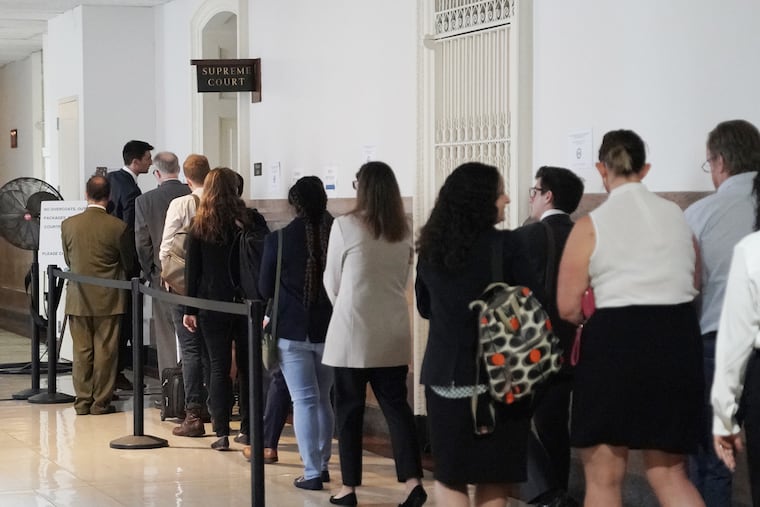Pennsylvania Supreme Court is right to reject petition against death penalty | Opinion
Stronger eyewitness identification and standards of proof can chart a reasonable middle course between abolition and the status quo.

On Thursday, the Pennsylvania Supreme Court sidestepped a decision on whether the death penalty violates the Pennsylvania Constitution. Two death-row inmates, Jermont Cox and Kevin Marinelli, filed petitions seeking to invoke the court’s rarely used “King’s Bench” jurisdiction. The court held this was not an appropriate case for its “extraordinary” jurisdiction but left open the possibility of revisiting the constitutionality question.
Cox and Marinelli argued the death penalty must be abolished because it violates the constitutional ban on “cruel punishments.”
They invoked the standard arguments. The system is broken. Capital defendants receive poor legal representation. There is a disparate impact on black defendants.
But the linchpin, as stated in their petitions, is the death penalty is so unreliable we may execute an innocent person: “The justice system cannot guarantee that an innocent person will not be convicted and sentenced to death.” And that, so the argument goes, is a risk too great to take.
First things first. For the court to strike down the death penalty as “cruel” under all circumstances, it will have to ignore no fewer than three constitutional provisions in Article I that sanction capital punishment.
Section 9 provides that no one can be “deprived of his life” without due process. Under Section 14, individuals arrested are entitled to bail except “for capital offenses.” And Pennsylvania’s double-jeopardy clause in Section 10 prohibits placing a person twice “in jeopardy of life or limb.”
The court would also have to overturn dozens of its prior decisions that upheld the constitutionality of the death penalty. To justify nullifying three explicit constitutional provisions and disregard for its own precedent, the court needs a compelling explanation for holding that cruel now has a different, more capacious meaning than it did before.
To be sure, way too many innocent people have been convicted. One study claims a 4.1% wrongful conviction rate. But the risk in capital cases can be greatly reduced — indeed, eliminated.
The biggest culprit for wrongful convictions has been flawed eyewitness identifications. The General Assembly should mandate that whenever the prosecution relies upon eyewitnesses, the jury should be instructed to view the identification with special care accompanied by strong corroborating evidence. The jury should also be instructed to carefully consider the reliability of the ID when the eyewitness and the offender are of different races or ethnic groups, and whether this or other biases may have shaped the testimony.
Kirk Bloodsworth was convicted of murder and sentenced to death based largely on eyewitness testimony. He became the first person exonerated through DNA, which was not available at the time of his trial. DNA has been a blessing, exonerating wrongfully convicted defendants while also solving decades-old cold cases. These DNA-based exonerations show that the system can work. DNA is now as likely to clear suspects before trial as after.
Finally, the risk of executing an innocent person can be reduced to zero by adopting a commonsense proposal that has surprisingly gained little traction. Well-respected federal judges, Circuit Judge Jon O. Newman and the late District Judge Leonard Sand, advocated that we raise the requisite standard of proof.
Under such proposals, the trial judge or jury must independently evaluate all the trial evidence and certify that guilt was proven beyond all possible doubt before imposing a death sentence.
The current beyond a reasonable doubt standard, the most stringent in the law, has failed to prevent miscarriages of justice in capital cases. Increasing the penalty-phase burden of proof to absolute certainty should assuage legitimate fears that an innocent person may die, such as where there is “residual doubt” as to the identity of the murderer or a defendant who presents a plausible (but not airtight) alibi.
The General Assembly determined that capital punishment serves legitimate ends, retribution among them. Retribution is society’s expression that some murders are so barbaric that any punishment other than death trivializes the enormity of the crime.
The proposals by Judges Newman and Sand, together with stronger eyewitness identification instructions, chart a reasonable middle course between abolition and the status quo. If the death penalty is abolished, it should be by the General Assembly reflecting the will of the people, not by a majority of the seven justices on the Pennsylvania Supreme Court.
George Ferko (no relation to the Ferko String Band) is a former state and federal prosecutor. He is retired and lives in Arizona.